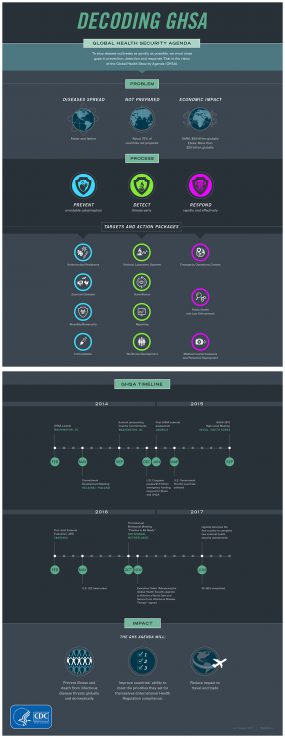Getting Ahead of the Next Pandemic: Is the World Ready?
Press Release
For Immediate Release: Thursday, October 26, 2017
Contact: Media Relations
(404) 639-3286
When a deadly mystery illness was detected in Liberia in April 2017, first responders were on the ground within 24 hours. Through the Ministry of Health’s quick action and collaboration with global partners, the cause of the outbreak was identified as meningococcal disease and contained with only 31 cases and 13 deaths. In stark contrast, when Ebola struck Liberia just three years ago, it took the country months to mount an effective response; thousands of lives were lost as responders raced to control the growing epidemic.
The difference between these two outbreaks is just one example of the progress made since 2014 to advance the Global Health Security Agenda’s (GHSA) goal to strengthen countries’ response capacities. GHSA is a global effort to save lives and reduce the impact of disease threats – whether naturally occurring or manmade – by stopping them at their source.
A new article released today in CDC’s Emerging Infectious Diseases (EID) journal details early results of CDC’s global health security work through collaboration with 17 partner countries. Implementing the Global Health Security Agenda in 17 Countries: Contributions by the Centers for Disease Control and Prevention shows how CDC is accelerating progress toward a world more prepared for public health threats. Part of EID’s new Global Health Security Supplement, the article outlines CDC-supported progress during the first two years of GHSA implementation.
With supplemental funding from the U.S. Government of $582 million over five years (FY 2015 – 2019), CDC is supporting Liberia and 16 other GHSA countries in strengthening core public health systems to rapidly detect, respond, and prevent the spread of disease and limit the impact of outbreaks on families, communities, and whole economies. These efforts include strengthening:
- Surveillance systems to rapidly detect and report cases.
- Laboratory networks to accurately identify the cause of illness.
- A workforce of disease detectives and rapid responders to identify, track, and contain outbreaks.
- Emergency operations systems to coordinate an effective response.
“These core areas are a platform for a functioning public health system in any country and are critical for effective disease detection and response,” said Rebecca Bunnell, Ph.D., deputy director for science, policy, and communication in CDC’s Division of Global Health Protection and senior author of the article. “From meningococcal disease in Liberia to yellow fever in Uganda, outbreaks can be contained and pandemics prevented when countries have these core capabilities in place.”
A timely look at progress toward GHSA milestones
This week, GHSA partner countries, including the United States, meet in Kampala, Uganda, for the 4th High Level GHSA Ministerial Meeting to discuss sustaining and extending these critical efforts.
“In a world more interconnected than ever – where emerging diseases continually threaten people’s health and drug resistance continues to grow – ensuring the safety and security of all people requires strong, diverse partnerships and a global commitment to GHSA beyond 2018,” said Rebecca Martin, Ph.D., director of CDC’s Center for Global Health.
The CDC report describes progress to meet GHSA milestones and concludes that, overall, GHSA partner countries (Phase I) were successful in expanding their capacity for combating public health threats. The analysis found more than 675 advancements across the 17 countries as a result of CDC’s GHSA work, including these:
- Disease Surveillance: Thirteen countries (76 percent) expanded surveillance systems for three or more syndromes (for example, severe acute respiratory syndrome, acute flaccid paralysis, acute hemorrhagic fever, and acute watery diarrhea with dehydration) that signal possible public health emergencies.
- Laboratory Systems: Sixteen countries (94 percent) acquired new diagnostic equipment and capabilities (such as specimen test kits) to detect priority pathogens like influenza, polio, HIV, TB, typhoid fever, and cholera.
- Workforce Development: All 17 countries participated in three-month Frontline Field Epidemiology Training Programs (FETP) designed to put disease detectives on the ground who know how to identify, track, and contain outbreaks. These included new Frontline programs in 14 countries.
- Emergency Management and Response: Fourteen countries trained emergency operations center staff in basic public health emergency management, giving them the necessary skills to coordinate an efficient and effective response.

